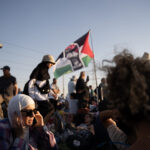This analysis was featured in Critical State, a weekly newsletter from Inkstick Media and The World. Subscribe here.
Last week, Critical State looked at new research on how local officials in the Philippines are coping with COVID-19 in areas where rebel groups violently contest the central state’s control. This week, we take a deep dive into how local communities are handling COVID-19 in places where the obstacles separating the communities and the central state are less political and more geological.
In the Pacific archipelago nation of Vanuatu, made up of 80 islands that stretch across more than 800 miles of ocean, the cost of projecting state power to the edges of the country is high on a good day. The costs rise dramatically on the not-infrequent days when one of the country’s many active volcanoes begins to spew ash and lava or during cyclone season, when Vanuatu finds itself in the path of major storms. In the months since COVID-19 was first confirmed in Vanuatu, communities have been forced to deal with the pandemic alongside those and other environmental threats that have challenged the government’s ability to execute public health interventions.
A research team from the Australian National Center for Ocean, Resources and Security and the Vanuatu Fisheries Department ran a survey at the start of the pandemic to see how communities coping with the costs imposed by natural disasters and environmental threats were adapting to the COVID-19 era. As if to underscore the exact problem their work highlights, the researchers conducted their survey by the only viable method for efficiently contacting local officials scattered across the country: they called their respondents on the phone.
In the months since COVID-19 was first confirmed in Vanuatu, communities have been forced to deal with the pandemic alongside those and other environmental threats that have challenged the government’s ability to execute public health interventions.
In those phone calls, the discrepancy in government response between the more populous central islands and the more remote islands was clear. None of the seven sites on remote islands that researchers contacted had been visited by provincial task force teams working to spread information about COVID-19. By contrast, all but three of the 16 sites on primary and secondary islands included in the survey had hosted members of the provincial task forces. Yet the country’s long history with natural disasters also increased the ability of local communities to respond to the pandemic even without direct government intervention. Community disaster committees, which grew out of responses to earlier cyclones, were reactivated in many communities and tasked with everything from distributing information about social distancing to improving local food production to reduce the need for travel between islands. Information about which programs to implement was distributed by the government via radio, cell phone and social media, but in many cases it was these community organizations actually doing the implementation.
This turn toward self-sufficiency had some negative effects, however. Increased fishing to make up for a lack of food imports led to cases of ciguatera poisoning, as inexperienced fishers caught contaminated reef fish. The local merchants who supply imported goods to outlying islands faced mounting debts as the COVID-19 restrictions prevented them from doing business. Most starkly, people mostly just didn’t want to stay in remote areas if they could avoid it. Populations in areas where people could travel shot up in the weeks after COVID-19 restrictions were put in place. The migration put some strain on resources in the central islands, but it also allowed people to access government aid that would not reach them if they remained in more remote areas.
In all, remote Vanuatu communities seem to have been quick and flexible in their COVID-19 response, even in the absence of direct intervention from the central government. The country’s history of decentralized disaster response proved valuable in areas where intersecting challenges of distance, resource strain and environmental threat prevented the state from offering uniform public health services across the islands.



















